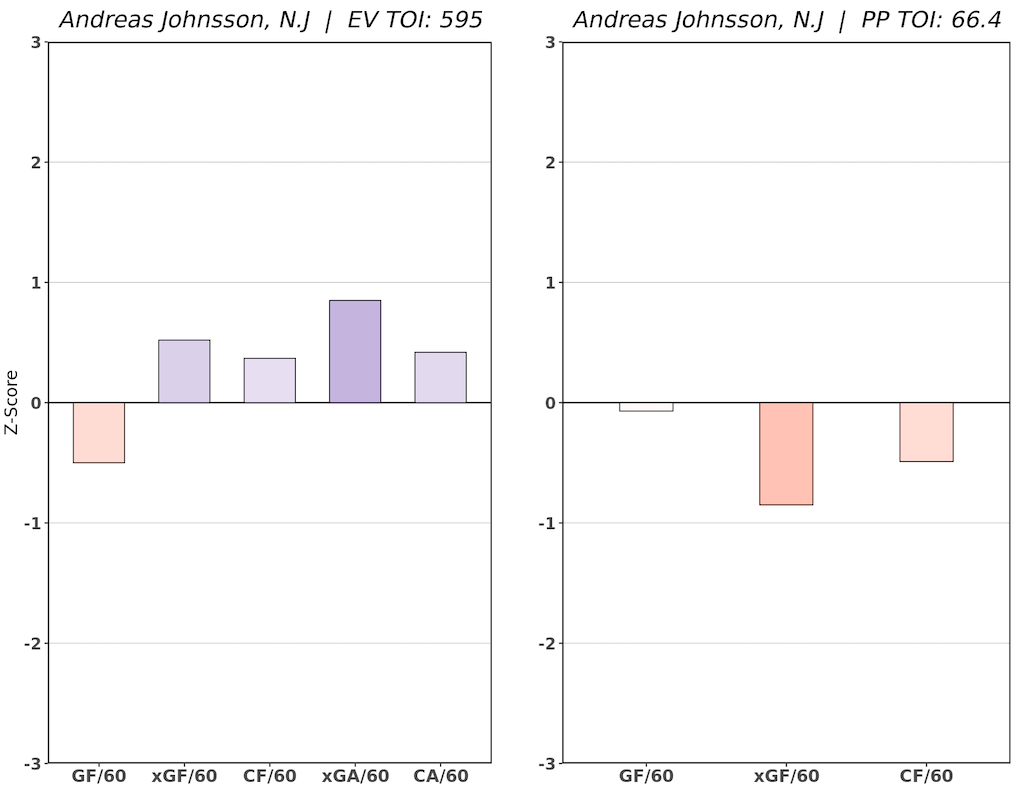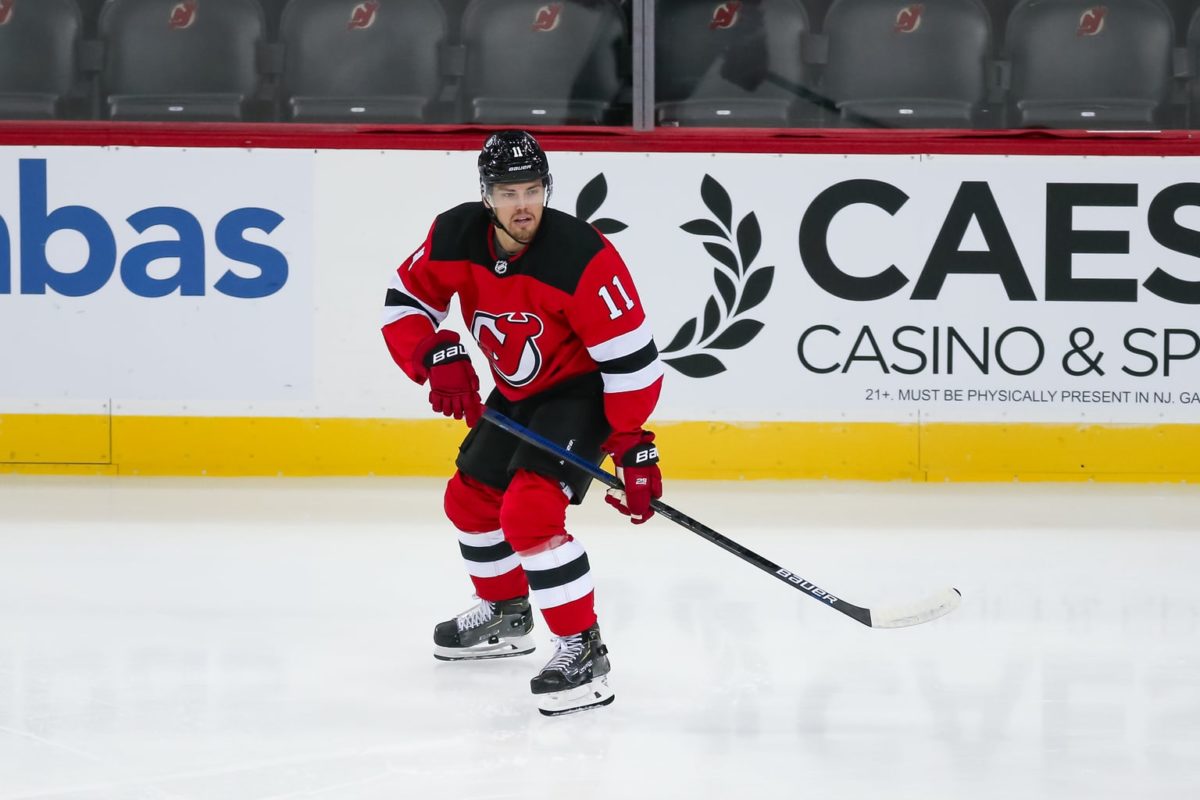It was not an easy season for Andreas Johnsson. From a rough bout with COVID to the condensed schedule, the cards quickly stacked against him after the team’s COVID outbreak. He finished with 11 points in 50 games — an 18-point pace over 82 games — which was by far the worst scoring pace of his career.
Johnsson may have taken a lot of flack on social media for his performance and lack of production. But in what was a weird season affected by a pandemic, there are signs that he’s due for some positive regression that gets him back to looking like the player he was with the Toronto Maple Leafs. Let’s take a look at his 2020-21 campaign and why the Devils should make an effort to protect him at the upcoming Seattle Kraken Expansion Draft.
Johnsson’s 2020-21 Season
There’s no way around it; Johnsson did not have the season many envisioned when the Devils acquired him from the Maple Leafs. But before getting into his numbers, it’s important to note his experience with COVID and how it affected him. In his exit interview, he mentioned how his conditioning was out of sorts for almost a month after he had COVID and that his asthma may have played a role as well. In a shortened season where the Devils played four games every six nights for almost three months after their outbreak, that surely didn’t help him.
But despite the condensed schedule and his bout with COVID, Johnsson put up some solid numbers at five-on-five. His Corsi for percentage (CF%) of 53.4 percent was fourth-best on the team among players with 100-plus minutes logged, while his expected goals percentage (xG%) of 52.3 percent ranked fifth-best. Even when adjusted for score effects, both of those numbers come in well above 50 percent.
Related: Devils’ Biggest Needs in 2021 Offseason
And while it may have seemed like the Devils were giving up a lot of goals with Johnsson on the ice, their goal differential was only minus-1 at five-on-five. That’s not far off from his xG%, which indicated he should have a goal differential of plus-2 at that game state. In fact, he was one of the team’s best shot suppressing forwards and had good defensive impacts.
Johnsson’s defensive worth showed up in his goals above replacement (GAR), as his even-strength defense was worth a GAR of 2. His overall GAR of 3.9 was fifth-best on the Devils, while his wins above replacement of 0.7 tied for fourth-best with Miles Wood and Janne Kuokkanen. Overall, he had a positive impact at even strength despite putting up career-worst scoring rates:

Finally, there’s Johnsson’s individual point percentage (IPP). First, what is IPP? IPP is a metric that measures how often a player received a point when his team scored a goal while he was on the ice. This season, Johnsson’s IPP dropped to 40 percent. The league average IPP for forwards is around 68 percent, and Johnsson’s IPP was 64.9 percent over his previous two seasons.
IPP is a useful tool to identify when a player had an odd bad season and when he may be due to bounce back and vice versa. In Johnsson’s case, it’s the former. And if that’s any indication, it makes a strong argument for the Devils keeping him and banking on him producing closer to his 40-45 point career norms in 2021-22.
Johnsson Should Be on Devils’ Protection List
This is going to be an unpopular take with plenty of Devils fans, but general manager Tom Fitzgerald should look to protect Johnsson at this July’s expansion draft. Their plan is pretty straightforward; they’re going to protect seven forwards, three defensemen, and a goalie. It’s selecting that seventh forward that will be tricky. Will it be Johnsson, Michael McLeod, or Nathan Bastian?
All three have protection cases. McLeod had his best season to date and finished at a 14-goal pace over 82 games. He became one of the team’s top penalty killers and made his case to be the Devils’ fourth-line center for next season. Likewise, Bastian became a mainstay on the penalty kill and fourth line and played with a bit of an edge like McLeod.
With that said, neither McLeod nor Bastian have the offensive upside of Johnsson. They play their roles well, but their ceilings aren’t much higher than fourth-liners. When healthy and on his game, Johnsson is an effective middle-six winger who can contribute 15 to 20 goals and 40 to 45 points. Before his trade to the Devils, he was one of the Maple Leafs’ most efficient five-on-five scorers, so he has a track record of showing he can produce.
If Devils leave Johnsson exposed, it’s probably safe to say that the Kraken will select him. Kraken general manager Ron Francis has assembled a smart hockey ops department, including a first-class analytics team. They’re going to have done their homework on Johnsson, so they’ll be aware he’s a good bounce-back candidate for 2021-22. He’s also only 26 years old and has a manageable cap hit of $3.4 million for two more seasons, so that will only make him more attractive to the Kraken.

From the Devils’ perspective, they have to decide who would be the bigger loss. Would losing McLeod or Bastian’s depth and penalty-killing be a more significant loss than Johnsson’s potential rebound? I can certainly see that being the case for McLeod because head coach Lindy Ruff values him, but it’s harder to replace scoring wingers than bottom-six forwards. Plus, would the Kraken even select McLeod or Bastian if the Devils left them exposed?
If the Devils leave defenseman Will Butcher available for the Kraken, which seems like a safe assumption at this point, he appears to be the perfect expansion pick. He struggled this season but had posted good underlying numbers in his previous three NHL seasons. It appears he could use a change of scenery, as his skating doesn’t seem to fit well with Ruff’s fast-paced system. So if left exposed along with McLeod or Bastian, he’s probably a good bet to be the Kraken’s selection, keeping McLeod and Bastian in New Jersey. That won’t be the case if Johnsson is left unprotected.
Related: Devils to Watch in the 2021 IIHF World Championship
It may not seem like it, but Johnsson is better than the player you saw this season. He finished with 43 points in 2018-19 and produced at a 40-point pace with the Maple Leafs in 2019-20, and his 7.7 shooting percentage this season was well below his career 12 percent mark. With four months until training camp in September and time to recuperate after having COVID, he should look more like himself in 2021-22. And if the Devils are smart, they’ll make the bet it happens with them and not with the Kraken or any other club.
* * *
Advanced stats from Natural Stat Trick, Evolving-Hockey